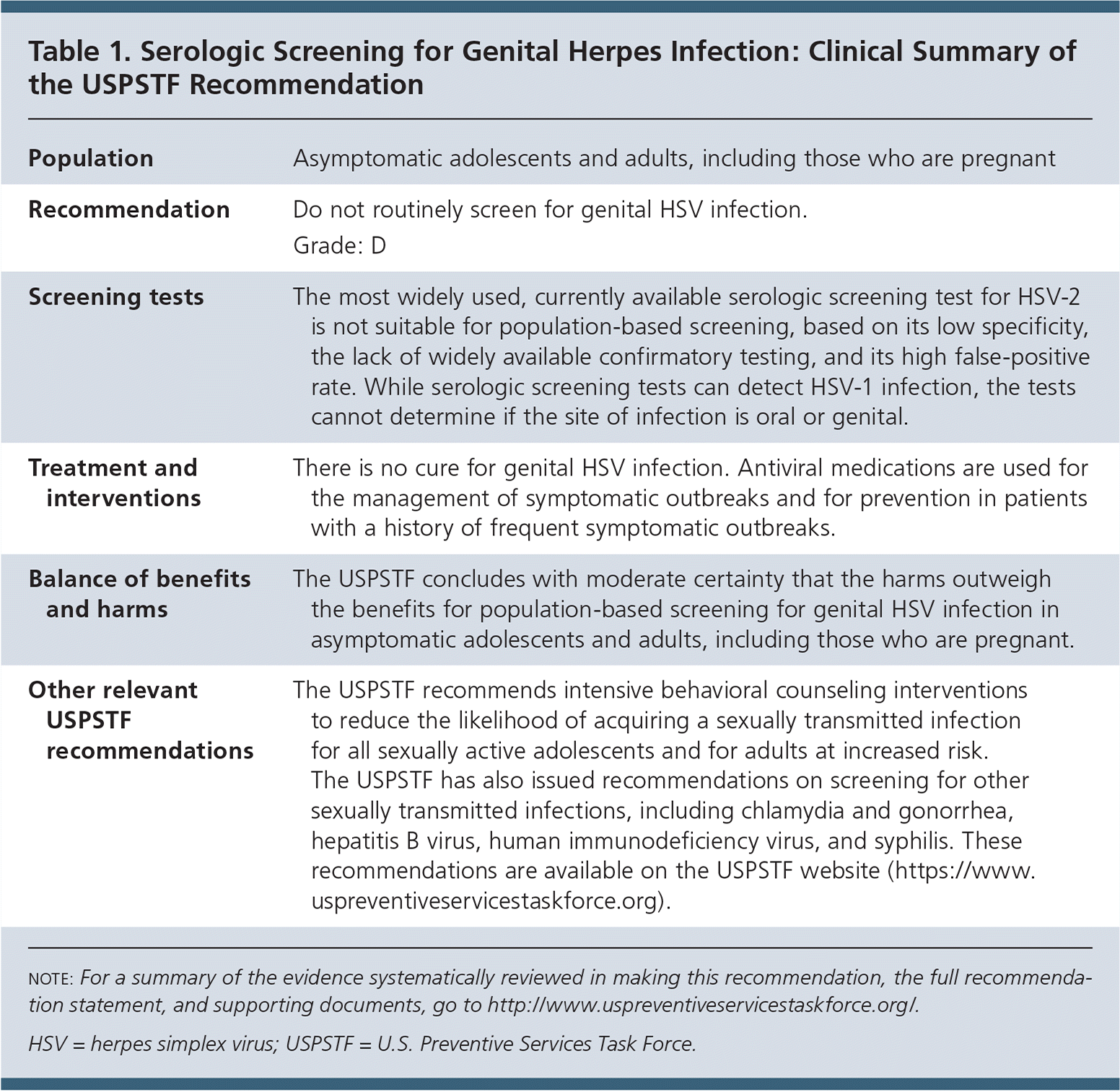
Am Fam Physician. 2017;95(12):online
Related Putting Prevention into Practice: Serologic Screening for Genital Herpes Infection.
As published by the U.S. Preventive Services Task Force.
Summary of Recommendation and Evidence
The USPSTF recommends against routine serologic screening for genital herpes simplex virus (HSV) infection in asymptomatic adolescents and adults, including those who are pregnant (Table 1). D recommendation.

| Population | Asymptomatic adolescents and adults, including those who are pregnant |
| Recommendation | Do not routinely screen for genital HSV infection. |
| Grade: D | |
| Screening tests | The most widely used, currently available serologic screening test for HSV-2 is not suitable for population-based screening, based on its low specificity, the lack of widely available confirmatory testing, and its high false-positive rate. While serologic screening tests can detect HSV-1 infection, the tests cannot determine if the site of infection is oral or genital. |
| Treatment and interventions | There is no cure for genital HSV infection. Antiviral medications are used for the management of symptomatic outbreaks and for prevention in patients with a history of frequent symptomatic outbreaks. |
| Balance of benefits and harms | The USPSTF concludes with moderate certainty that the harms outweigh the benefits for population-based screening for genital HSV infection in asymptomatic adolescents and adults, including those who are pregnant. |
| Other relevant USPSTF recommendations | The USPSTF recommends intensive behavioral counseling interventions to reduce the likelihood of acquiring a sexually transmitted infection for all sexually active adolescents and for adults at increased risk. |
| The USPSTF has also issued recommendations on screening for other sexually transmitted infections, including chlamydia and gonorrhea, hepatitis B virus, human immunodeficiency virus, and syphilis. These recommendations are available on the USPSTF website (https://www.uspreventiveservicestaskforce.org). |
Rationale
IMPORTANCE
Genital herpes is a prevalent sexually transmitted infection (STI) in the United States; the Centers for Disease Control and Prevention (CDC) estimates that almost 1 in 6 persons aged 14 to 49 years have genital herpes.1 Genital herpes infection is caused by 2 subtypes of HSV, HSV-1 and HSV-2. Unlike other infections for which screening is recommended, HSV infection may not have a long asymptomatic period during which screening, early identification, and treatment may alter its course. Antiviral medications may provide symptomatic relief from outbreaks; however, these medications do not cure HSV infection. Although vertical transmission of HSV can occur between an infected pregnant woman and her infant during vaginal delivery, interventions can help reduce transmission. Neonatal herpes infection, while uncommon, can result in substantial morbidity and mortality.
DETECTION
In the past, most cases of genital herpes in the United States have been caused by infection with HSV-2. Adequate evidence suggests that the most widely used, currently available serologic screening test for HSV-2 approved by the U.S. Food and Drug Administration is not suitable for population-based screening, based on its low specificity, the lack of widely available confirmatory testing, and its high false-positive rate. Rates of genital herpes due to HSV-1 infection in the United States may be increasing. While HSV-1 infection can be identified by serologic tests, the tests cannot determine if the site of infection is oral or genital; thus, these serologic tests are not useful for screening for asymptomatic genital herpes resulting from HSV-1 infection.
BENEFITS OF EARLY DETECTION AND INTERVENTION
Based on limited evidence from a small number of trials on the potential benefit of screening and interventions in asymptomatic populations and an understanding of the natural history and epidemiology of genital HSV infection, the USPSTF concluded that the evidence is adequate to bound the potential benefits of screening in asymptomatic adolescents and adults, including those who are pregnant, as no greater than small.
HARMS OF EARLY DETECTION AND INTERVENTION
Based on evidence on potential harms from a small number of trials, the high false-positive rate of the screening tests, and the potential anxiety and disruption of personal relationships related to diagnosis, the USPSTF found that the evidence is adequate to bound the potential harms of screening in asymptomatic adolescents and adults, including those who are pregnant, as at least moderate.
USPSTF ASSESSMENT
The USPSTF concludes with moderate certainty that the harms outweigh the benefits for population-based screening for genital HSV infection in asymptomatic adolescents and adults, including those who are pregnant.
Clinical Considerations
PATIENT POPULATION UNDER CONSIDERATION
This recommendation statement applies to asymptomatic adolescents and adults, including those who are pregnant, without a history of genital HSV infection.
SCREENING TESTS
The USPSTF does not recommend serologic screening for genital HSV infection in asymptomatic persons.
TREATMENT
The CDC provides guidance for the diagnosis and management of genital HSV infection.2
ADDITIONAL APPROACHES TO PREVENTION
The USPSTF recommends intensive behavioral counseling interventions to reduce the likelihood of acquiring an STI for all sexually active adolescents and for adults at increased risk.3